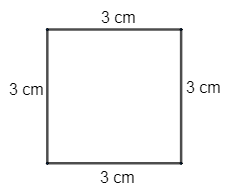
A square has a perimeter of 12 centimeters. How do you find the length of the diagonal of the square?
Answer
529.2k+ views
Hint: We are given a square whose perimeter has 12cm, we are asked to find the length of the diagonal of the square. To do so, we will learn first about square, how are perimeter of square related to its side, then we learn how side are related to the diagonal, we will also use Pythagoras theorem ${{P}^{2}}={{B}^{2}}+{{H}^{2}}$ to solve our problem.
Complete step-by-step solution:
We are given a square whose perimeter is 12 cm.
We know that a square is a regular 4 sided polygon so all sides are equal.
Perimeter of any degree is the sum of all sides.
Since in square all sides are equal, so perimeter of square is $4\times sides.$
We are given perimeter of square as 12 cm so, perimeter $=12cm$ .
As we know $\text{Perimeter }=4\times \text{side}$ .
So, we get –
$4\times \text{side=12}$ (as perimeter $=12$ )
So, dividing both side by 4, we get –
$\dfrac{4\times \text{side}}{4}=\dfrac{12}{4}$
$\Rightarrow \text{side}=3$
So, we get a side of a square of 3cm.

Now, we have to find the length of the diagonal to do so we first see what one diagonal the line joining the opposite and of the vertex of the square are called as diagonal.

Now as we know SQUARE has ${{90}^{\circ }}$ angle at each vertex so sides and diagonal form a right angle triangle. We have a side of length 3cm and diagonal say D.

So, we will use Pythagoras theorem which say ${{P}^{2}}+{{B}^{2}}={{H}^{2}}$
We have Base $B=3$ and Perpendicular $P=3cm$ and hypotenuse as Diagonal D. So, we get –
${{D}^{2}}={{3}^{2}}+{{3}^{2}}$
As ${{3}^{2}}=9$ so,
${{D}^{2}}=9+9=18$ so,
${{D}^{2}}=18$
By simplifying, we get –
$\begin{align}
& D=\sqrt{18} \\
& =\sqrt{3\times 3\times 2} \\
\end{align}$
As 3 is making a pair, so it came out. We get –
$D=3\sqrt{2}cm$
Length of diagonal is $3\sqrt{2}cm$.
Note: We should be using Pythagoras theorem carefully it is always ${{P}^{2}}+{{B}^{2}}={{H}^{2}}$ , if we change the value as ${{P}^{2}}+{{H}^{2}}={{B}^{2}}$ or ${{P}^{2}}={{H}^{2}}+{{B}^{2}}$ or ${{P}^{2}}-{{B}^{2}}={{H}^{2}}$ , they all will lead us to get incorrect solution, also while finding diagonal we should remember length are always positive. So, ${{D}^{2}}=18\Rightarrow D=3\sqrt{2}$ , we do not discuss negative signs as it can never be an available option for length of diagonal.
Complete step-by-step solution:
We are given a square whose perimeter is 12 cm.
We know that a square is a regular 4 sided polygon so all sides are equal.
Perimeter of any degree is the sum of all sides.
Since in square all sides are equal, so perimeter of square is $4\times sides.$
We are given perimeter of square as 12 cm so, perimeter $=12cm$ .
As we know $\text{Perimeter }=4\times \text{side}$ .
So, we get –
$4\times \text{side=12}$ (as perimeter $=12$ )
So, dividing both side by 4, we get –
$\dfrac{4\times \text{side}}{4}=\dfrac{12}{4}$
$\Rightarrow \text{side}=3$
So, we get a side of a square of 3cm.

Now, we have to find the length of the diagonal to do so we first see what one diagonal the line joining the opposite and of the vertex of the square are called as diagonal.

Now as we know SQUARE has ${{90}^{\circ }}$ angle at each vertex so sides and diagonal form a right angle triangle. We have a side of length 3cm and diagonal say D.

So, we will use Pythagoras theorem which say ${{P}^{2}}+{{B}^{2}}={{H}^{2}}$
We have Base $B=3$ and Perpendicular $P=3cm$ and hypotenuse as Diagonal D. So, we get –
${{D}^{2}}={{3}^{2}}+{{3}^{2}}$
As ${{3}^{2}}=9$ so,
${{D}^{2}}=9+9=18$ so,
${{D}^{2}}=18$
By simplifying, we get –
$\begin{align}
& D=\sqrt{18} \\
& =\sqrt{3\times 3\times 2} \\
\end{align}$
As 3 is making a pair, so it came out. We get –
$D=3\sqrt{2}cm$
Length of diagonal is $3\sqrt{2}cm$.
Note: We should be using Pythagoras theorem carefully it is always ${{P}^{2}}+{{B}^{2}}={{H}^{2}}$ , if we change the value as ${{P}^{2}}+{{H}^{2}}={{B}^{2}}$ or ${{P}^{2}}={{H}^{2}}+{{B}^{2}}$ or ${{P}^{2}}-{{B}^{2}}={{H}^{2}}$ , they all will lead us to get incorrect solution, also while finding diagonal we should remember length are always positive. So, ${{D}^{2}}=18\Rightarrow D=3\sqrt{2}$ , we do not discuss negative signs as it can never be an available option for length of diagonal.
Recently Updated Pages
Master Class 12 Business Studies: Engaging Questions & Answers for Success

Master Class 12 Economics: Engaging Questions & Answers for Success

Master Class 12 English: Engaging Questions & Answers for Success

Master Class 12 Maths: Engaging Questions & Answers for Success

Master Class 12 Social Science: Engaging Questions & Answers for Success

Master Class 12 Chemistry: Engaging Questions & Answers for Success

Trending doubts
Full Form of IASDMIPSIFSIRSPOLICE class 7 social science CBSE

Convert 200 Million dollars in rupees class 7 maths CBSE

One lakh eight thousand how can we write it in num class 7 maths CBSE

What are the controls affecting the climate of Ind class 7 social science CBSE

List of coprime numbers from 1 to 100 class 7 maths CBSE

Write a letter to the editor of the national daily class 7 english CBSE





